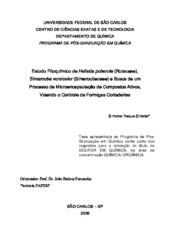Estudo fitoquímico de Helietta puberula (Rutaceae), Simarouba versicolor (Simaroubaceae) e busca de um processo de microencapsulação de compostos ativos visando o controle de formigas cortadeiras.
Abstract
This work involved the
bioassay-guided study of Helietta puberula (Rutaceae) e Simarouba versicolor
(Simaroubaceae). The biossays were carried out with leaf-cutting ants Atta
sexdens rubropilosa, antifungal activity against the symbiotic fungus
Leucoagaricus gongylophorus and inhibition of the enzymatic activity of
pectinases. The results obtained with extracts and fractions showed that the
selected plants were promising source of compounds in the control against leafcutting
ants. The phytochemical investigation of active extracts and fractions
allowed the isolation of 31 compounds of differences types such as: steroids ( β-
sitosterol, stigmasterol, sitostenone, stigmastenone, campestenone and 3 β-O-3 β-
D-glucopyranosil sitosterol); triterpenes of the tirucalane type (22S,3 α-
dihydroxytirucal-7,24-dien-23-one), esqualene (eurilene) and lupanic (lupeol
and lupenone); quinoline alkaloids (N-metil-4-methoxy-2-quinolone),
furoquinolinic alkaloids (dictamine, γ-fagarine, kokusaginine, maculine,
flindersiamine), acridonic alkaloids (arborinine); canthinonic alkaloids (4,5-
dimethoxycanthin-6-one and 5-methoxycanthin-6-one) and of the β-carboline
types of alkaloids (7-hidroxy-ethyl β-carboline and 7-hidroxy-1,1 -propyonate of
methyl β-carboline); flavonoids (flavone, isosakuranetine and 5,7,3 ,4 ,5 -
pentamethoxyflavone); one stilbene (22); coumarins (7-hidroxycoumarin, 6,7-
dimethoxycoumarin, 6-hydroxy-7,8-dimethoxycoumarin, 3 -(1 ,1 -
dimethylalyl)-isoescopoletin, methylether-graveliferone); quassinoids
(glaucarubolone and glaucarubinone) and two cinnamic acids derivatives
(methyl 3,4,5-trimethoxycinnamate and geranyl 3,4-dimethoxycinnamate).
Among these substances, furoquinoline and canthinonic alkaloids, flavone and
the quassinoids were active against the L. gongylophorus fungus; inhibiting
100% of its grownth and also showed inhibition against leaf-cutting ants
survivel biossay. The study of chitosan as matriz on the microencapsulation
process; to the encapsulation of the bioactive compound, reduction of the
mammalian toxicity, protection Humans and also the environment; showed very
promising results, but more study is necessary mainly to reduce the size of the
particle
